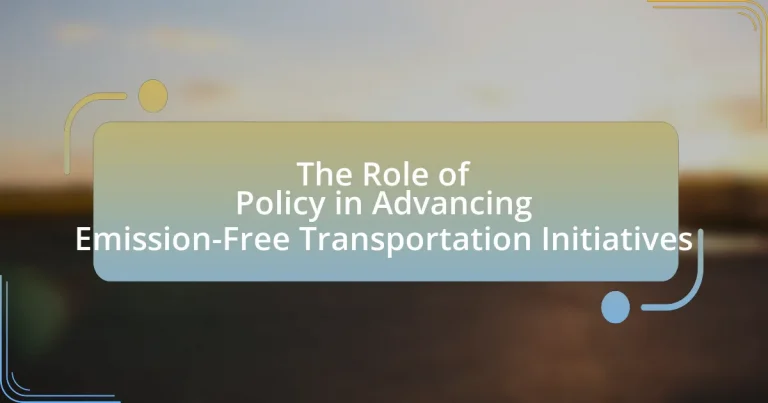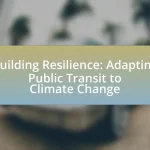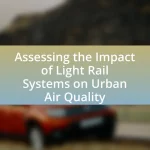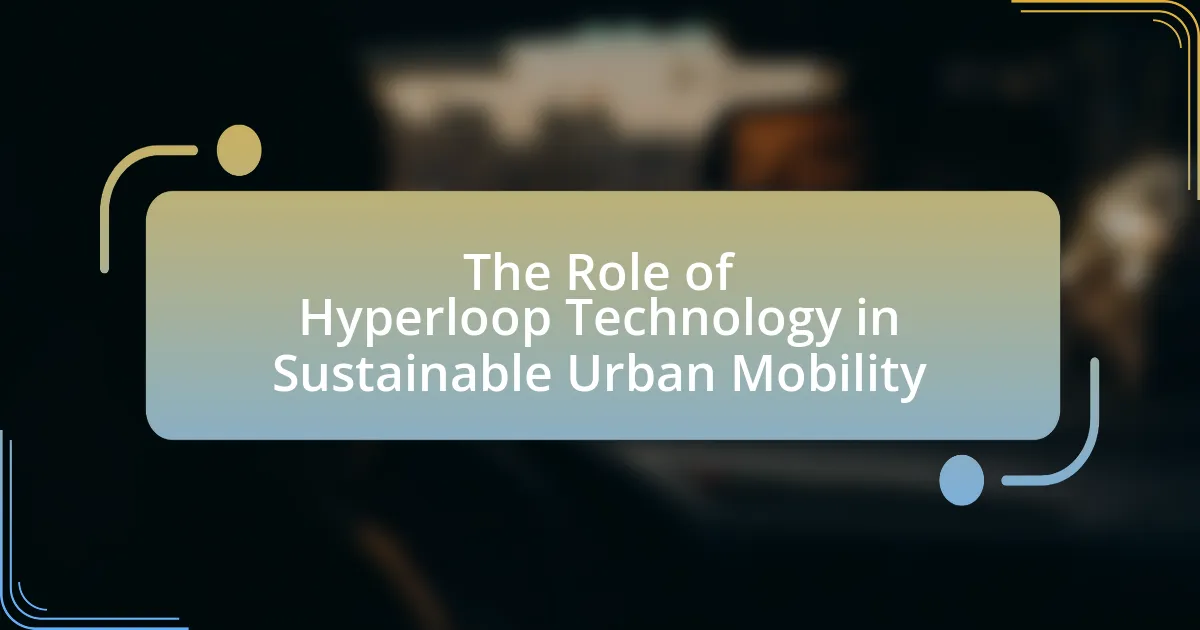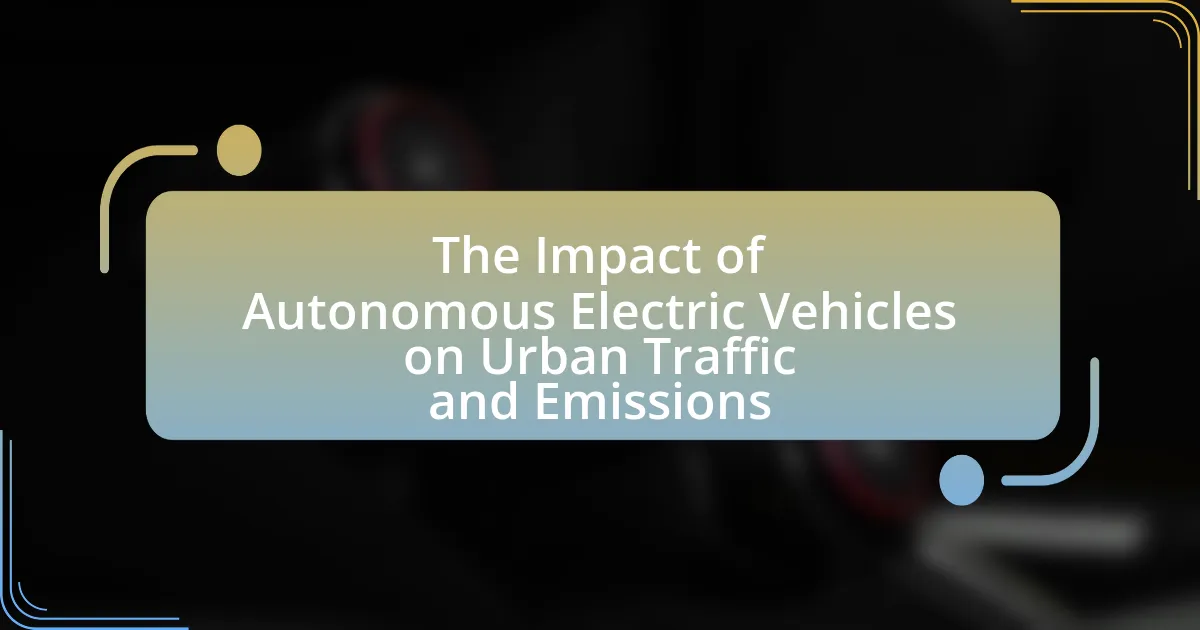The article focuses on the critical role of policy in advancing emission-free transportation initiatives. It outlines how effective policies, including regulatory frameworks, financial incentives, and research funding, drive the adoption of clean technologies and promote sustainable transportation. Key examples include the European Union’s Green Deal and various national incentives that have successfully increased electric vehicle sales. The article also discusses the challenges and best practices in implementing these policies, emphasizing the importance of stakeholder engagement and metrics for evaluating success in reducing greenhouse gas emissions and improving air quality.
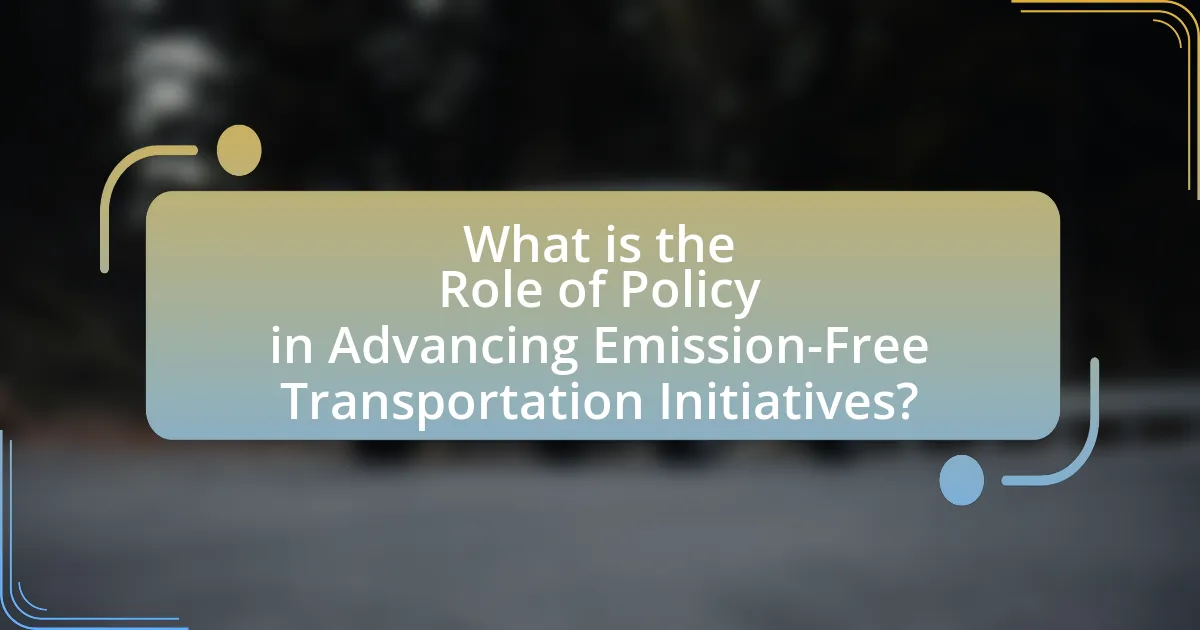
What is the Role of Policy in Advancing Emission-Free Transportation Initiatives?
Policy plays a crucial role in advancing emission-free transportation initiatives by establishing regulatory frameworks, providing financial incentives, and setting ambitious targets for emissions reductions. Effective policies, such as subsidies for electric vehicles and investments in charging infrastructure, encourage consumer adoption and industry innovation. For instance, the European Union’s Green Deal aims to reduce greenhouse gas emissions by at least 55% by 2030, which includes significant investments in sustainable transport. Additionally, policies that promote research and development in clean technologies further accelerate the transition to emission-free transportation.
How do policies influence the development of emission-free transportation?
Policies significantly influence the development of emission-free transportation by establishing regulatory frameworks, providing financial incentives, and promoting research and development. Regulatory frameworks, such as emissions standards and fuel economy regulations, compel manufacturers to innovate and produce cleaner vehicles. For instance, the European Union’s stringent CO2 emissions targets for cars have driven automakers to invest heavily in electric vehicle technology. Financial incentives, including tax credits and subsidies for electric vehicles, lower the cost barrier for consumers, thereby increasing adoption rates. According to the International Council on Clean Transportation, countries that implemented such incentives saw a substantial rise in electric vehicle sales. Furthermore, policies that fund research and development initiatives, like the U.S. Department of Energy’s investments in battery technology, accelerate advancements in emission-free transportation solutions.
What types of policies are most effective in promoting emission-free transportation?
Incentive-based policies, such as subsidies for electric vehicles and investments in charging infrastructure, are most effective in promoting emission-free transportation. These policies encourage consumers to adopt cleaner technologies by reducing the upfront costs associated with electric vehicles. For instance, countries like Norway have implemented substantial tax exemptions and grants, resulting in over 54% of new car sales being electric in 2020. Additionally, regulatory measures like emissions standards and low-emission zones compel manufacturers to innovate and produce more sustainable transportation options. Evidence from California shows that stringent emissions regulations have led to significant reductions in greenhouse gas emissions from the transportation sector.
How do government regulations impact the adoption of emission-free technologies?
Government regulations significantly accelerate the adoption of emission-free technologies by providing financial incentives, setting mandatory standards, and creating a favorable market environment. For instance, regulations such as tax credits for electric vehicles and renewable energy mandates encourage consumers and manufacturers to invest in cleaner technologies. According to a report by the International Energy Agency, countries with stringent emissions regulations saw a 30% increase in electric vehicle sales from 2019 to 2020, demonstrating the direct correlation between regulatory frameworks and technology adoption. Additionally, regulations that impose penalties on high-emission vehicles further incentivize the shift towards emission-free alternatives, reinforcing the role of policy in promoting sustainable transportation initiatives.
Why is policy essential for achieving emission-free transportation goals?
Policy is essential for achieving emission-free transportation goals because it establishes regulatory frameworks and incentives that drive innovation and investment in clean technologies. Effective policies, such as emissions standards and subsidies for electric vehicles, create a predictable environment that encourages manufacturers and consumers to adopt sustainable practices. For instance, the implementation of the European Union’s Green Deal aims to reduce greenhouse gas emissions from transport by at least 90% by 2050, demonstrating how targeted policy can lead to significant reductions in emissions.
What are the long-term benefits of implementing emission-free transportation policies?
Implementing emission-free transportation policies leads to significant long-term benefits, including improved public health, reduced greenhouse gas emissions, and enhanced energy security. Improved public health results from decreased air pollution, which is linked to respiratory and cardiovascular diseases; studies indicate that cleaner air can reduce healthcare costs by billions annually. Reduced greenhouse gas emissions contribute to climate change mitigation, with transportation accounting for approximately 29% of total U.S. emissions, according to the Environmental Protection Agency. Enhanced energy security arises from decreased reliance on fossil fuels, promoting the use of renewable energy sources and stabilizing energy prices. These benefits collectively support sustainable urban development and economic growth.
How do policies address the challenges of transitioning to emission-free transportation?
Policies address the challenges of transitioning to emission-free transportation by implementing regulations, providing financial incentives, and investing in infrastructure. Regulations, such as emissions standards and fuel efficiency requirements, compel manufacturers to produce cleaner vehicles. Financial incentives, including tax credits and rebates for electric vehicle purchases, lower the cost barrier for consumers, encouraging adoption. Additionally, investments in charging infrastructure and public transportation systems facilitate the use of emission-free vehicles. For instance, the U.S. government allocated $7.5 billion for electric vehicle charging infrastructure as part of the Bipartisan Infrastructure Law, demonstrating a commitment to overcoming logistical challenges in this transition.
What role do international agreements play in shaping emission-free transportation policies?
International agreements play a crucial role in shaping emission-free transportation policies by establishing binding commitments and frameworks for countries to reduce greenhouse gas emissions. These agreements, such as the Paris Agreement, set specific targets for emissions reductions and encourage nations to adopt cleaner transportation technologies and practices. For instance, the Paris Agreement aims to limit global warming to well below 2 degrees Celsius, prompting countries to invest in electric vehicles and public transportation systems that produce zero emissions. Additionally, international agreements facilitate collaboration and knowledge sharing among nations, enabling the development of best practices and innovative solutions for sustainable transportation.
How do global climate agreements influence national transportation policies?
Global climate agreements significantly influence national transportation policies by setting binding targets for emissions reductions that countries must meet. These agreements, such as the Paris Agreement, compel nations to develop and implement policies that promote sustainable transportation options, such as electric vehicles and public transit systems. For instance, countries that commit to reducing greenhouse gas emissions often allocate funding for infrastructure that supports low-emission transport, thereby aligning national policies with international climate goals. Additionally, these agreements encourage collaboration and knowledge sharing among nations, leading to the adoption of best practices in transportation policy that further advance emission-free initiatives.
What are the implications of international cooperation on emission-free transportation initiatives?
International cooperation on emission-free transportation initiatives leads to enhanced technological exchange and standardized regulations, which accelerate the adoption of clean technologies. Collaborative efforts, such as the Paris Agreement, encourage countries to share best practices and innovations, resulting in improved efficiency and reduced costs for developing emission-free transport solutions. For instance, the European Union’s Green Deal aims to harmonize policies across member states, facilitating a unified approach to reducing transport emissions. This cooperation not only fosters economic growth through shared investments but also strengthens global commitments to climate goals, as evidenced by the collective reduction targets set by participating nations.
How can local governments contribute to emission-free transportation initiatives?
Local governments can contribute to emission-free transportation initiatives by implementing policies that promote the use of electric vehicles (EVs) and public transportation. For instance, they can establish incentives such as tax rebates for EV purchases and invest in charging infrastructure to support EV adoption. According to the International Council on Clean Transportation, cities that have invested in EV infrastructure have seen a significant increase in electric vehicle registrations, demonstrating the effectiveness of such policies. Additionally, local governments can enhance public transit systems, making them more efficient and accessible, which encourages residents to opt for public transport over personal vehicles. This approach not only reduces emissions but also alleviates traffic congestion, as evidenced by studies showing that improved public transit can lead to a decrease in single-occupancy vehicle use.
What specific policies can municipalities implement to support emission-free transportation?
Municipalities can implement specific policies such as establishing low-emission zones, providing incentives for electric vehicle (EV) adoption, and investing in public transportation infrastructure to support emission-free transportation. Low-emission zones restrict access for high-emission vehicles, thereby encouraging the use of cleaner alternatives. Incentives, such as tax rebates or subsidies for EV purchases, have been shown to increase EV adoption rates significantly; for instance, California’s Clean Vehicle Rebate Project has led to over 400,000 rebates since its inception. Additionally, investing in public transportation infrastructure, including electric buses and bike-sharing programs, can reduce reliance on personal vehicles, further decreasing emissions. These policies collectively create an environment conducive to emission-free transportation.
How do local policies align with national and international emission-free transportation goals?
Local policies align with national and international emission-free transportation goals by implementing regulations and incentives that promote sustainable transportation options. For instance, many cities adopt policies that encourage the use of electric vehicles through tax rebates, charging infrastructure development, and low-emission zones, which directly support national targets like the U.S. goal of achieving net-zero emissions by 2050. Additionally, local governments often collaborate with national initiatives, such as the Paris Agreement, by setting specific emissions reduction targets that mirror international commitments, thereby ensuring that local actions contribute to broader climate objectives. This alignment is evidenced by the increasing number of cities committing to the Global Covenant of Mayors for Climate and Energy, which emphasizes the importance of local action in achieving global emission reduction goals.
What are the key challenges in implementing effective emission-free transportation policies?
The key challenges in implementing effective emission-free transportation policies include high initial costs, inadequate infrastructure, and resistance from stakeholders. High initial costs arise from the need for investment in new technologies and vehicles, which can deter governments and private entities from adopting these policies. Inadequate infrastructure, such as charging stations for electric vehicles, limits the practicality and accessibility of emission-free options, making it difficult for consumers to transition. Additionally, resistance from stakeholders, including the fossil fuel industry and consumers accustomed to traditional vehicles, complicates policy adoption and enforcement. These challenges hinder the overall effectiveness of emission-free transportation initiatives.
How do economic factors affect the success of emission-free transportation initiatives?
Economic factors significantly influence the success of emission-free transportation initiatives by determining funding availability, consumer adoption rates, and infrastructure development. For instance, government subsidies and incentives can lower the cost of electric vehicles, making them more accessible to consumers; a study by the International Council on Clean Transportation found that incentives can increase electric vehicle sales by up to 50%. Additionally, the cost of renewable energy sources impacts the operational expenses of emission-free transportation systems, as lower energy costs can enhance the viability of electric public transit. Furthermore, economic conditions, such as fuel prices and economic growth, directly affect consumer behavior and investment in sustainable transport solutions. Thus, favorable economic conditions and supportive financial policies are crucial for the successful implementation and expansion of emission-free transportation initiatives.
What social barriers must be overcome to advance emission-free transportation policies?
To advance emission-free transportation policies, social barriers such as public skepticism, lack of awareness, and resistance to change must be overcome. Public skepticism often stems from misinformation about the feasibility and benefits of emission-free technologies, which can hinder acceptance and adoption. Lack of awareness about the environmental impacts of traditional transportation and the advantages of emission-free alternatives can prevent individuals from supporting necessary policy changes. Additionally, resistance to change is prevalent in communities reliant on fossil fuel-based transportation, where economic interests and established habits create significant inertia against adopting new practices. Addressing these barriers through education, community engagement, and transparent communication about the benefits of emission-free transportation is essential for fostering public support and facilitating policy implementation.
What best practices can be adopted for successful emission-free transportation policy implementation?
Successful emission-free transportation policy implementation can be achieved by adopting best practices such as establishing clear regulatory frameworks, incentivizing clean technologies, and promoting public-private partnerships. Clear regulatory frameworks provide guidelines that ensure compliance and accountability, which are essential for effective policy execution. For instance, countries like Norway have implemented stringent emissions targets that have significantly increased electric vehicle adoption, with electric cars accounting for over 54% of new car sales in 2020.
Incentivizing clean technologies through subsidies and tax breaks encourages both consumers and manufacturers to transition to emission-free options. The U.S. federal tax credit for electric vehicles, which offers up to $7,500, has been instrumental in boosting electric vehicle sales.
Promoting public-private partnerships fosters collaboration between government entities and private companies, facilitating innovation and resource sharing. For example, the partnership between the city of Los Angeles and private firms to develop electric bus fleets has led to a significant reduction in greenhouse gas emissions.
These best practices, supported by concrete examples, demonstrate effective strategies for implementing successful emission-free transportation policies.
How can stakeholder engagement enhance the effectiveness of emission-free transportation policies?
Stakeholder engagement enhances the effectiveness of emission-free transportation policies by fostering collaboration, ensuring diverse perspectives are considered, and increasing public support. Engaging stakeholders such as local communities, businesses, and environmental organizations allows policymakers to identify specific needs and concerns, leading to more tailored and effective solutions. For instance, studies show that regions with active stakeholder involvement in transportation planning report higher satisfaction and compliance rates with emission-reduction initiatives. This collaborative approach not only improves policy design but also facilitates smoother implementation, as stakeholders are more likely to advocate for and adhere to policies they helped shape.
What metrics should be used to evaluate the success of emission-free transportation initiatives?
To evaluate the success of emission-free transportation initiatives, key metrics include greenhouse gas emissions reduction, adoption rates of emission-free vehicles, and improvements in air quality. Greenhouse gas emissions reduction quantifies the decrease in carbon dioxide and other harmful emissions, providing a direct measure of environmental impact. Adoption rates of emission-free vehicles indicate the percentage of new vehicle sales that are electric or otherwise emission-free, reflecting consumer acceptance and market penetration. Improvements in air quality can be assessed through metrics such as reductions in particulate matter and nitrogen oxides, which are critical for public health and environmental sustainability. These metrics collectively provide a comprehensive assessment of the effectiveness and impact of emission-free transportation initiatives.
